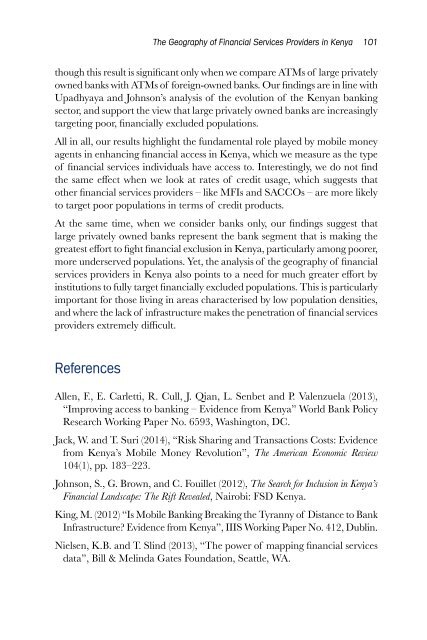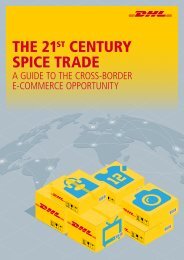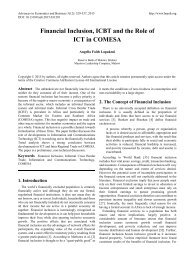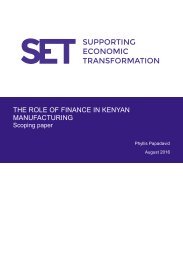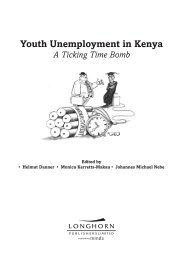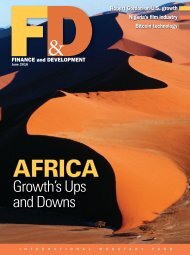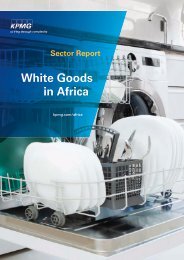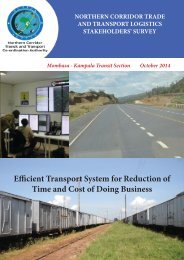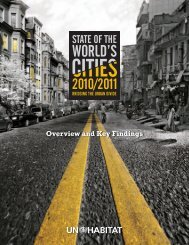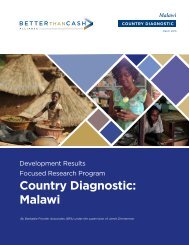in the 21st Century
hTOE305aYVW
hTOE305aYVW
You also want an ePaper? Increase the reach of your titles
YUMPU automatically turns print PDFs into web optimized ePapers that Google loves.
The Geography of F<strong>in</strong>ancial Services Providers <strong>in</strong> Kenya 101<br />
though this result is significant only when we compare ATMs of large privately<br />
owned banks with ATMs of foreign-owned banks. Our f<strong>in</strong>d<strong>in</strong>gs are <strong>in</strong> l<strong>in</strong>e with<br />
Upadhyaya and Johnson’s analysis of <strong>the</strong> evolution of <strong>the</strong> Kenyan bank<strong>in</strong>g<br />
sector, and support <strong>the</strong> view that large privately owned banks are <strong>in</strong>creas<strong>in</strong>gly<br />
target<strong>in</strong>g poor, f<strong>in</strong>ancially excluded populations.<br />
All <strong>in</strong> all, our results highlight <strong>the</strong> fundamental role played by mobile money<br />
agents <strong>in</strong> enhanc<strong>in</strong>g f<strong>in</strong>ancial access <strong>in</strong> Kenya, which we measure as <strong>the</strong> type<br />
of f<strong>in</strong>ancial services <strong>in</strong>dividuals have access to. Interest<strong>in</strong>gly, we do not f<strong>in</strong>d<br />
<strong>the</strong> same effect when we look at rates of credit usage, which suggests that<br />
o<strong>the</strong>r f<strong>in</strong>ancial services providers – like MFIs and SACCOs – are more likely<br />
to target poor populations <strong>in</strong> terms of credit products.<br />
At <strong>the</strong> same time, when we consider banks only, our f<strong>in</strong>d<strong>in</strong>gs suggest that<br />
large privately owned banks represent <strong>the</strong> bank segment that is mak<strong>in</strong>g <strong>the</strong><br />
greatest effort to fight f<strong>in</strong>ancial exclusion <strong>in</strong> Kenya, particularly among poorer,<br />
more underserved populations. Yet, <strong>the</strong> analysis of <strong>the</strong> geography of f<strong>in</strong>ancial<br />
services providers <strong>in</strong> Kenya also po<strong>in</strong>ts to a need for much greater effort by<br />
<strong>in</strong>stitutions to fully target f<strong>in</strong>ancially excluded populations. This is particularly<br />
important for those liv<strong>in</strong>g <strong>in</strong> areas characterised by low population densities,<br />
and where <strong>the</strong> lack of <strong>in</strong>frastructure makes <strong>the</strong> penetration of f<strong>in</strong>ancial services<br />
providers extremely difficult.<br />
References<br />
Allen, F., E. Carletti, R. Cull, J. Qian, L. Senbet and P. Valenzuela (2013),<br />
“Improv<strong>in</strong>g access to bank<strong>in</strong>g – Evidence from Kenya” World Bank Policy<br />
Research Work<strong>in</strong>g Paper No. 6593, Wash<strong>in</strong>gton, DC.<br />
Jack, W. and T. Suri (2014), “Risk Shar<strong>in</strong>g and Transactions Costs: Evidence<br />
from Kenya’s Mobile Money Revolution”, The American Economic Review<br />
104(1), pp. 183–223.<br />
Johnson, S., G. Brown, and C. Fouillet (2012), The Search for Inclusion <strong>in</strong> Kenya’s<br />
F<strong>in</strong>ancial Landscape: The Rift Revealed, Nairobi: FSD Kenya.<br />
K<strong>in</strong>g, M. (2012) “Is Mobile Bank<strong>in</strong>g Break<strong>in</strong>g <strong>the</strong> Tyranny of Distance to Bank<br />
Infrastructure? Evidence from Kenya”, IIIS Work<strong>in</strong>g Paper No. 412, Dubl<strong>in</strong>.<br />
Nielsen, K.B. and T. Sl<strong>in</strong>d (2013), “The power of mapp<strong>in</strong>g f<strong>in</strong>ancial services<br />
data”, Bill & Mel<strong>in</strong>da Gates Foundation, Seattle, WA.


